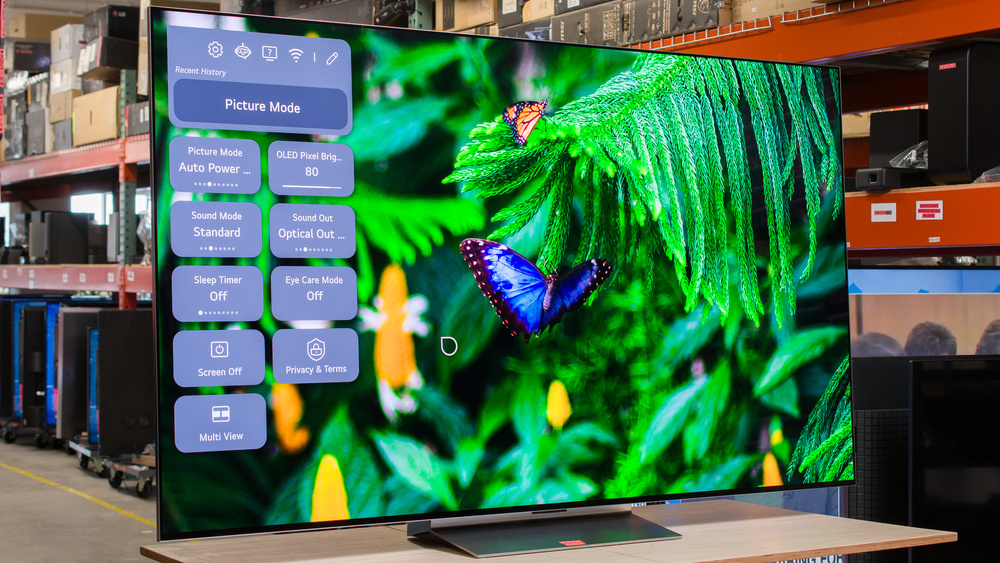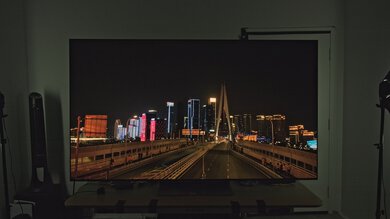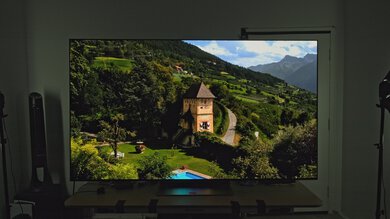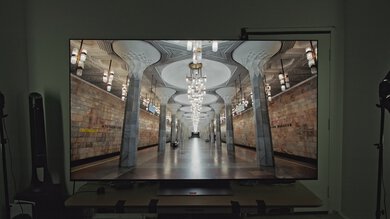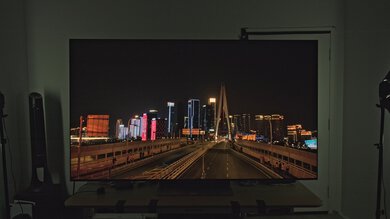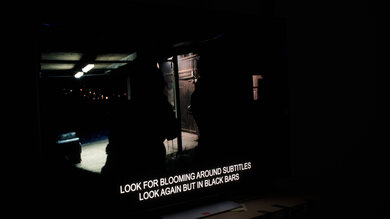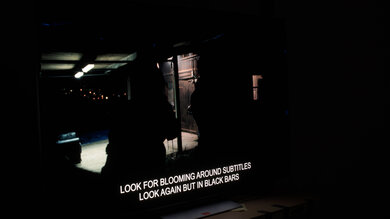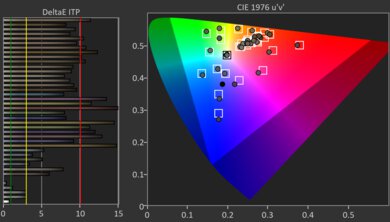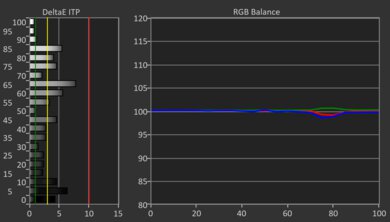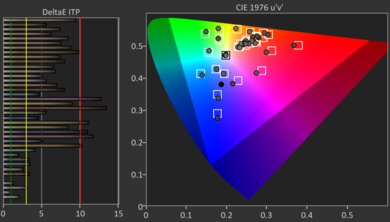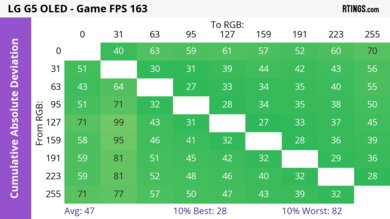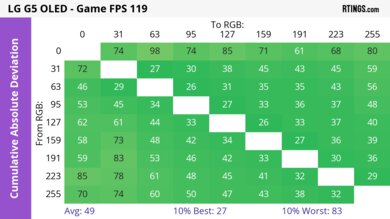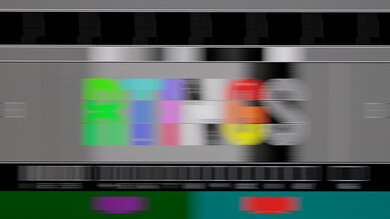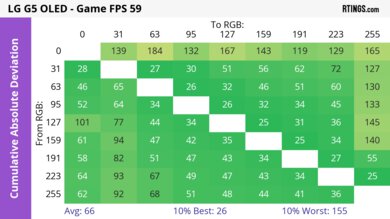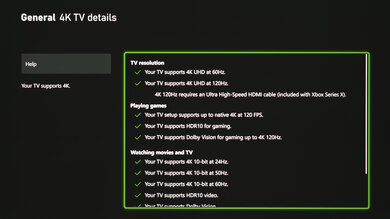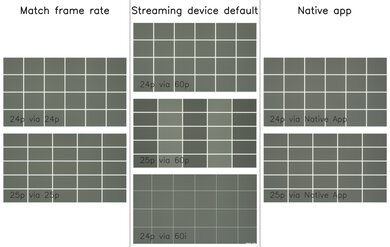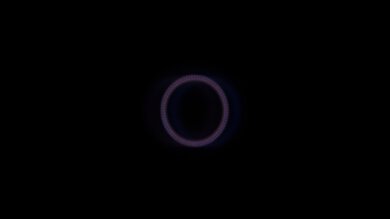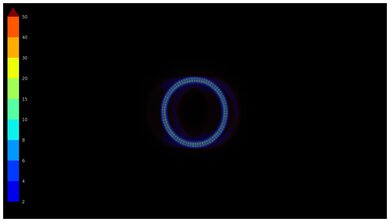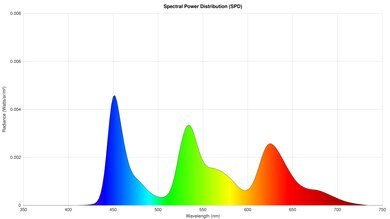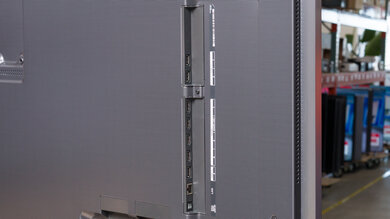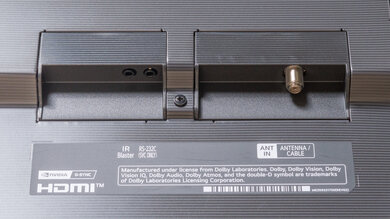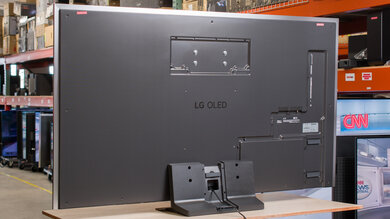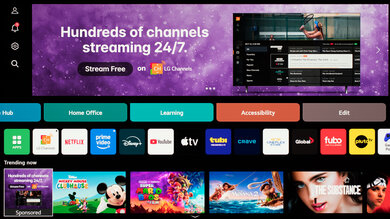LG has been releasing OLED models since 2013, and the technology really started to catch on with enthusiasts with the release of their 2016 C Series model. Since then, LG has been steadily releasing new OLED models on a yearly basis. These OLEDs have always used WOLED panels, with incremental upgrades to brightness and features each year. In 2023, LG released their first G Series OLED that utilized MLA technology for increased brightness, but this technology really didn't do a lot to help compete with the color saturation you get on QD-OLEDs from competing brands like Sony and Samsung. However, things have changed with the release of their new primary RGB tandem panel. This new panel is still a WOLED but is designed to increase brightness even further and deliver a wider range of colors than their previous OLED models.
The LG G5 OLED is the first TV to utilize this new technology. This flagship TV sits at the top of their 2025 lineup, above the LG B5 OLED and the LG C5 OLED. It uses the Alpha 11 AI processor Gen 2 and has a full suite of advanced features, like HDMI 2.1 bandwidth on all four ports, VRR, and up to 4k @ 165Hz. It also supports the popular Dolby Vision HDR format, has LG's Game Optimizer picture mode that is designed with performance in mind, and runs the 2025 version of LG's webOS. We bought and tested the 77-inch model, but it's also available in 55, 65, 83, and 97-inch sizes. However, the 97-inch model doesn't utilize the new primary RGB tandem panel or MLA technology.
Our Verdict
The LG G5 is amazing for mixed usage. It looks fantastic in a dark room thanks to its perfect black levels and punchy colors. You also barely lose any image quality when you flip your lights on, and the TV has the reflection handling and brightness needed to overcome glare. The TV has a plethora of modern gaming features, and it's fully compatible with all modern consoles and even pairs well with high-end gaming PCs. It's even a great option for large seating arrangements due to its wide viewing angle, so this is a TV that does it all.
Near-infinite contrast ratio for perfect blacks with no blooming around bright highlights.
Incredibly wide viewing angle for a consistent image from the sides.
Excellent SDR brightness in all scenes.
Colors are vibrant, lifelike, bright, and accurate.
Solid reflection handling means it overcomes glare in a bright room.
The LG G5 is fantastic for a home theater. You get those perfect black levels that OLEDs are known for, making it look stellar in a dark room. You also get amazing HDR brightness, so highlights really pop out against those perfect blacks, and bright scenes look spectacular. Colors are vivid, lifelike, and accurate in both SDR and HDR, so you get a vibrant viewing experience regardless of the content. Like all OLEDs, there's some response time stutter present, so slow camera movements aren't as smooth as they're intended to be.
Near-infinite contrast ratio for perfect blacks with no blooming around bright highlights.
Colors are vibrant, lifelike, bright, and accurate.
Amazing HDR brightness in all scenes.
Does an outstanding job upscaling and an excellent job cleaning up low bitrate content.
Amazing HDR brightness accuracy.
Noticeable stutter due to the TV's fast response time.
Doesn't passthrough DTS audio formats.
The LG G5 is excellent for a bright room. It's more than bright enough to overcome glare from indirect light sources, and it does a great job reducing the intensity of direct reflections, so there are no visibility issues in a bright room. The TV maintains its color vibrancy, and blacks stay nice and deep in a room with ambient lighting, meaning you don't have to trade in very much picture quality when you flip your lights on.
Excellent SDR brightness in all scenes.
Solid reflection handling means it overcomes glare in a bright room.
Blacks remain deep and colors stay vibrant in a room with ambient lighting.
The LG G5 is excellent for watching sports. Combined with its solid reflection handling, the TV is easily bright enough to overcome glare, regardless of the sport you're watching. It does an outstanding job upscaling and cleaning up artifacts in heavily compressed feeds, leaving you with a smooth and sharp enough image to enjoy when the quality of the game you're watching isn't ideal. Colors are vibrant and accurate, so you get an impactful viewing experience where your favorite team's jerseys look the way they should. It also has an excellent viewing angle, so you or your friends can sit anywhere in the room and enjoy a mostly consistent image.
Incredibly wide viewing angle for a consistent image from the sides.
Excellent SDR brightness in all scenes.
Colors are vibrant, lifelike, bright, and accurate.
Does an outstanding job upscaling and an excellent job cleaning up low bitrate content.
Solid reflection handling means it overcomes glare in a bright room.
The LG G5 is a superb gaming TV. It has HDMI 2.1 bandwidth on all four ports for up to 4k @ 165Hz with VRR, so it pairs excellently with consoles and gaming PCs. The TV has very low input lag for a responsive feel across its entire refresh rate range. It also has almost instantaneous pixel transitions, so fast motion is clear. Colors in games are nice and vivid in both SDR and HDR, and you get the perfect blacks OLEDs are known for, so its image quality is top-notch regardless of the title you're playing. This TV has truly amazing HDR brightness, so highlights really pop out in darker titles, and bright games are very impactful. To get the best image quality out of the TV without sacrificing performance, use Filmmaker Mode with ALLM enabled.
Low input lag for a very responsive experience.
Nearly instantaneous response time for no noticeable blur behind fast motion.
Colors are vibrant, lifelike, bright, and accurate.
Amazing HDR brightness in all scenes.
Diagonal lines caused by dithering are noticeable when sitting very close to the screen, limiting its usability as a PC monitor.
The LG G5 has amazing brightness overall. Its SDR brightness is excellent, so it easily overcomes glare in a bright room. The TV also has amazing HDR brightness, so small highlights really pop out against the rest of the image during darker scenes, and purely bright scenes are still very bright and impactful.
Excellent SDR brightness in all scenes.
Amazing HDR brightness in all scenes.
Since the LG G5 is an OLED, it displays remarkably deep and inky blacks with no blooming around highlights.
Near-infinite contrast ratio for perfect blacks with no blooming around bright highlights.
The LG G5 has excellent colors overall. It has amazing HDR color volume, so it displays dark colors and very bright colors with impact. The TV also has outstanding SDR color volume, which is helpful for the odd SDR content that utilizes wider color spaces, or if you like to push colors into a wider color space for added color saturation. This is an accurate TV out of the box, with incredible SDR color accuracy, meaning it doesn't require calibration. It's not quite as accurate in HDR, but it's still great, so everyone but the strictest color enthusiasts will be pleased.
Colors are vibrant, lifelike, bright, and accurate.
Note: We're in the process of improving our tests related to image processing, but this score should give you a general idea of how a TV performs overall with its image processing capabilities.
The LG G5 has excellent processing capabilities. It does an outstanding job upscaling low-resolution content, leaving you with a sharp enough image to enjoy. It also does an excellent job smoothing out artifacts in low-bitrate feeds without wiping away too much detail. The brightness of HDR content respects the content creator's intent due to its amazing PQ EOTF tracking, which is great if you care about accuracy. The TV does an excellent job handling color gradients overall, with only minor banding that's barely noticeable in real content.
Does an outstanding job upscaling and an excellent job cleaning up low bitrate content.
Amazing HDR brightness accuracy.
The LG G5 has outstanding responsiveness while using the Game Optimizer. The TV has HDMI 2.1 bandwidth on all four ports, supports up to 4k @ 165Hz, and is compatible with all three of the most common VRR formats. Its nearly instantaneous pixel transitions mean motion is sharp across its refresh range, except for some persistence blur at 60Hz, but this is expected. The TV has very low input lag across the board when using the TV's game mode, which is great for competitive gamers.
Low input lag for a very responsive experience.
Nearly instantaneous response time for no noticeable blur behind fast motion.
We're in the process of fixing the way we evaluate a TV's overall motion handling. This section is currently broken, and the score isn't indicative of how well a TV handles motion overall.
Performance Usages
Changelog
-
Updated Oct 21, 2025:
This review has been updated to Test Bench 2.1. We wrote text for the newly added Micro-Judder test, refreshed the text in the updated Judder section, and tweaked the text in the renamed Response Time Stutter section.
- Updated Oct 21, 2025: We added text to the new Micro-Judder section and refreshed the text in the updated Judder and Response Time Stutter sections after converting the review to TV 2.1.
-
Updated Sep 10, 2025:
We rechecked the TV's HDR Native Gradient handling in all picture modes after firmware 33.21.81 and confirmed that all picture modes other than Standard and Vivid no longer have excessive banding.
-
Updated Sep 03, 2025:
Mentioned the newly reviewed Panasonic Z95B OLED in the PQ EOTF Tracking section.
Check Price
Differences Between Sizes And Variants
We bought and tested the 77-inch LG G5 OLED (OLED77G5WUA), but our results are also valid for the 55, 65, and 83-inch models. The massive 97-inch model doesn't have the new primary RGB tandem panel or an MLA layer, so it isn't as bright and doesn't have the same color performance as the smaller models. Note that the last three letters in the model number (WUA in this case) vary between retailers and individual regions, but there's no difference in performance. All sizes of the TV come with a wall mount instead of a stand in the U.S., but in some regions like Canada, the 55-inch and 65-inch can be purchased with a stand (SUB) or wall mount (WUA).
There's a 48-inch model (OLED48G56LS) that's only available in the U.K., but that variant doesn't perform the same as the larger sizes, so our results aren't valid for that size.
| Size | US Model | Primary RGB Tandem Panel |
|---|---|---|
| 55" | OLED55G5WUA | Yes |
| 65" | OLED65G5WUA | Yes |
| 77" | OLED77G5WUA | Yes |
| 83" | OLED83G5WUA | Yes |
| 97" | OLED97G5WUA | No |
Our unit was manufactured in March 2025, as seen on the label.
Popular TV Comparisons
The LG G5 OLED is an awesome TV. It excels for any usage; this is a TV that's amazing for gaming, home theaters, bright rooms during the day, and in large group settings. It truly does it all, and there are no glaring issues with the TV. It competes against QD-OLED flagship offerings from other brands, like the Samsung S95F OLED and the Sony BRAVIA 8 II OLED. Those two TVs still have the edge when it comes to colors, but the LG is close. However, the LG is the brighter TV and does a better job of retaining its image quality in a bright room.
For more options, check out our recommendations for the best OLED TVs, the best gaming TVs, and the best TVs for watching movies.
The LG G5 OLED is better than the LG C5 OLED. The G5 is brighter in SDR and has superior reflection handling, making it more suitable for very bright rooms. The G5 has better HDR brightness and color volume, delivering a more impactful HDR experience, although the C5 is no slouch with that. The G5 also has a slightly better upscaling and supports 165Hz, making it a bit more versatile.
The LG G5 OLED is better than the LG G4 OLED due to three key differences. The G5 is brighter overall, so it's better suited for bright rooms and delivers a more impactful HDR experience. The G5 also displays brighter and more vibrant colors, giving it punchier colors overall. Finally, the G5 supports 165Hz, whereas the G4 is limited to 144Hz, making it slightly better for PC gamers with powerful rigs.
The Samsung S95F and the LG G5 are both fantastic OLED TVs that deliver exceptional picture quality. The LG is slightly more enticing for use in a dark home theater, since it gets a bit brighter in HDR, has better processing, and supports Dolby Vision. However, the Samsung still looks incredible in dark rooms. In bright rooms, blacks are raised on the Samsung, but its anti-reflective coating is so effective that it essentially eliminates glare, making it the better choice for very bright environments. As good as the LG is, it has diagonal lines in darker scenes that are noticeable when sitting up close. It also exhibits snow-like noise in certain dark scenes that’s noticeable from a normal viewing distance, along with a few other issues that may bother some people, making it hard to recommend over the Samsung.
The LG G5 OLED is better overall than the Sony BRAVIA 8 II OLED. The LG is the much brighter TV overall, so it delivers more impactful highlights in HDR and overcomes a lot more glare in a well-lit room. The LG also does a superior job of retaining its black levels and color saturation in a bright room. When it comes to gaming performance, the LG is better since it provides lower input lag, up to 4k @ 165Hz, 4 HDMI 2.1 ports, and supports FreeSync. On the other hand, the Sony has the advantage when it comes to color vibrancy and gradient handling due to its QD-OLED panel.

We buy and test dozens of TVs yearly, taking an objective, data-driven approach to deliver results you can trust. Our testing process is complex, with hundreds of individual tests that take over a week to complete. Most of our tests are done with specially designed test patterns that mimic real content, but we also use the same sources you have at home to ensure our results match the real-world experience. We use two main tools for our testing: a Colorimetry Research CR-100 colorimeter and a CR-250 spectroradiometer.
Test Results

The LG G5 OLED has amazing HDR brightness. Small highlights are incredibly bright, so this TV easily displays most highlights in HDR content mastered at 600 and 1000 nits. Even more impressive is just how bright the TV is with entirely bright scenes, so you don't notice a massive decrease in luminance when bright elements are taking up large portions of the screen. It performs similarly to the Samsung S95F OLED, but small specular highlights are even brighter on the G5.
When compared to Mini LED models like the Samsung QN990F 8K, the G5 is brighter with small highlights, but not as bright with very bright scenes that fill the entire screen, like bright outdoor shots.
Our results above are with the TV set to Filmmaker Mode with 'Dynamic Tone Mapping' disabled. Below are the results with DTM turned on. As you can see, the setting almost doubles the peak luminance of our Hallway and Landscape real scene tests and adds over 350 nits of peak brightness when displaying our Cityscape test. Despite this massively increased luminance, there are not a ton of lost details in highlights, which is impressive. Still, this setting is inaccurate and goes against the content creator's intent.
- Hallway Lights: 2019 cd/m²
- Yellow Skyscraper: 1106 cd/m²
- Landscape Pool: 621 cd/m²
When the G5 was initially tested, it was on firmware 33.10.80, and the TV was even brighter when using the optional DTM feature. As of firmware 33.20.67, the peak brightness while using DTM is lower. This feature is now doing a better job of retaining detail in some highlights than it did prior to this firmware update, but it's not as bright overall. For reference, you can see the DTM peak brightness results before and after firmware 33.20.67.
There's no noticeable difference in HDR brightness when using the Game Optimizer. Our results above are with Dynamic Tone Mapping set to 'HGiG,' which is the most accurate setting.
The LG G5 OLED has excellent SDR brightness, and small portions of the screen are incredibly bright. What's so impressive is how bright the TV is during well-lit scenes, which is great if you enjoy a bright image or if you need an OLED that easily overcomes glare in a well-lit room.
Our results above are in the Dark Space, night picture mode. The results below are in Game Optimizer with the input label set to 'PC.' Note that using the 'PC' input label locks the 'Peak Brightness' setting to 'Off' in SDR, so it can't be adjusted.
- Peak 2%: 574 cd/m²
- Peak 10%: 574 cd/m²
- Peak 25%: 572 cd/m²
- Peak 50%: 564 cd/m²
- Peak 100%: 520 cd/m²
- Sustained 2%: 568 cd/m²
- Sustained 10%: 572 cd/m²
- Sustained 25%: 570 cd/m²
- Sustained 50%: 562 cd/m²
- Sustained 100%: 467 cd/m²
The LG G5 is an OLED without a backlight, so its self-lit pixels give it the same performance as a TV with perfect local dimming and no zone transitions. We still film the zone transition video on the TV so you can see how it compares to an option with local dimming.
The TV has great SDR color volume. Like almost any TV, it has full coverage of the most commonly used Rec.709 color space, but it also covers the entirety of the DCI-P3 color space. It doesn't display as much of the widest BT.2020 color space, but its coverage is still very good. This is a great TV to watch the odd SDR content that's mastered in these wider color spaces, and it's also a great choice if you like to force Rec.709/sRGB content into a wider color space for increased saturation.
| Volume ΔE³ | DCI-P3 Coverage |
BT.2020 Coverage |
|---|---|---|
| L10 | 98.59% | 76.17% |
| L20 | 98.91% | 75.87% |
| L30 | 99.11% | 76.73% |
| L40 | 99.45% | 79.63% |
| L50 | 99.85% | 81.32% |
| L60 | 99.95% | 81.49% |
| L70 | 100.00% | 76.04% |
| L80 | 100.00% | 74.27% |
| L90 | 100.00% | 76.56% |
| L100 | 100.00% | 95.00% |
| Total | 99.80% | 78.50% |
The TV has amazing HDR color volume. Due to its perfect contrast, it displays dark, saturated colors very well, and it also does well displaying very bright colors. This leads to vivid and punchy colors in HDR content that are sure to impress.
Even though firmware 33.11.35 drastically improved color volume in SDR, the TV's HDR color volume remains mostly unchanged.
Although it's amazing overall, it's not as good as the Samsung S95F OLED, as QD-OLED panels don't have to rely on a white subpixel to boost luminance. Therefore, bright colors are just as vibrant as pure white, which is not the case on the G5.
The TV has outstanding SDR color accuracy before calibration. Its white balance is fantastic, but certain shades of gray are a bit too bright while others are slightly too dark. Still, the TV's gamma is incredibly close to 2.2. Its color temperature is a bit cooler than the industry standard 6500K, but it's close enough that most people won't notice the difference. The accuracy of colors is incredible, with only very minor mapping errors that aren't noticeable. This is truly a TV that respects the content creator's intent out-of-the-box when using its accurate picture modes.
The TV has superb SDR color accuracy after calibration. It's very easy to calibrate, and any minor errors with white balance, color temperature, color accuracy, and gamma are now completely gone. However, since it's so accurate prior to calibration, these small fixes are barely noticeable, and anyone except the most ardent color purists will be more than satisfied with its accuracy out-of-the-box.
The TV supports AutoCal through Calman using a 1D and 3D LUT, which is great if you want to simplify the calibration process.
See our full calibration settings.
The LG G5 OLED has great HDR color accuracy before calibration. Its white balance is fantastic, with just a bit too much blue in some brighter grays, which contributes to the TV's slightly too cool color temperature. The accuracy of colors is good overall, but there are some mapping errors throughout its color gamut, most notably in warmer tones.
The TV has outstanding HDR color accuracy after calibration. There's no longer too much blue in brighter grays, so its white balance is improved, and the TV's color temperature is now much closer to 6500K. Color accuracy is now great overall, but there are still some mapping errors throughout, and some colors are undersaturated. Although overall color accuracy has improved, there's not a huge difference after calibration, so calibrating the TV is only worth it for keen-eyed color enthusiasts.
The LG G5 has amazing PQ EOTF tracking. Some mid-tones are displayed a bit brighter than intended, but the TV mostly stays very close to the content creator's intent. There's a small roll-off near the TV's peak brightness, which helps to retain detail in highlights that are brighter than the TV's capabilities. However, this is only useful for content mastered at 4000 nits since it's bright enough to fully display content mastered at 600 and 1000 nits.
Firmware 33.11.35 slightly improved out-of-the-box PQ EOTF tracking, but since our test is done after calibration, the results didn't change. If you want a similar TV with even better PQ EOTF tracking, the Panasonic Z95B OLED offers that.
The TV does an outstanding job upscaling DVDs, standard definition streams, and other low-resolution content. Some fine details are hard to make out, but the image is sharp enough for a pleasant viewing experience.
Firmware 33.11.35 was supposed to improve upscaling performance, but we didn't notice any major difference. However, the TV still has top-tier upscaling performance.
The LG G5 has excellent HDR native gradient handling. There's some very minor banding in some colors, but it's barely noticeable with real content.
When this TV launched, there was more noticeable banding due to an issue with HDR10, but that was fixed in Filmmaker Mode as of firmware 33.11.35. Other picture modes, like Game Optimizer, were still affected by the issue. However, as of firmware 33.21.81, the excessive banding has been fixed in all picture modes other than Standard and Vivid.
The TV has very low input lag overall. Its input lag at 60Hz is nothing out of the ordinary, and you get a responsive gaming experience. At 120Hz, the TV is very snappy and provides an incredibly responsive experience. Although the TV launched with higher-than-expected input lag at 165Hz, LG remedied the problem with firmware 33.11.35, and the TV now has only 4ms of delay at its maximum refresh rate.
Below are some additional input lag measurements.
4:3 @ 60Hz:
- 640x480: 27.0 ms
- 800x400: 33.7 ms
- 1024x768: 26.6 ms
Filmmaker Mode with Game Optimizer Enabled:
- 60Hz: 9.7 ms
- 120Hz: 5.1 ms
- 165Hz: 4 ms
Filmmaker Mode @ 23.976Hz
- 156.5 ms
The TV supports all common resolutions up to 4k @ 165Hz, and it supports chroma 4:4:4, so it has great compatibility with gaming consoles and PCs. It doesn't support 144Hz, but since most PC gamers are best off outputting a 165Hz refresh rate, this isn't a big deal.
The TV supports FreeSync and HDMI Forum VRR and is certified as G-SYNC compatible, ensuring a nearly tear-free gaming experience from any VRR-enabled source. It works well across the TV's entire refresh rate range and supports sources with Low-Frame-Compensation (LFC), which ensures your games remain nearly tear-free even when your frame rate drops very low.
The TV's CAD at 60Hz is fantastic. Most transitions from one RGB level to another are nearly instantaneous, but there's some overshoot when pixels transition from black to brighter shades. There's also still some noticeable persistence blur.
The LG G5 is fully compatible with everything the PS5 offers, like 1440p @ 120Hz and 4k @ 120Hz, as well as HDMI Forum VRR. It also supports Auto Low Latency Mode, so you don't have to worry about switching to Game Optimizer to get the lowest input lag.
The LG G5 is fully compatible with everything the Xbox Series X|S offers, including 1440p @ 120Hz, 4k @ 120Hz, HDMI Forum VRR, FreeSync Premium Pro, and Dolby Vision gaming. It also supports Auto Low Latency Mode, so you don't have to worry about switching to Game Optimizer to get the lowest input lag.
Unfortunately, due to the nearly instantaneous pixel response time of the TV, there's response time stutter with low frame rate content, which is most noticeable during slow panning shots.
The LG G5 is completely free from micro-judder with all 24p and 25p content, so motion in complex scenes is mostly smooth.
The LG G5 removes 24p and 25p judder from native apps and external devices that send a 24Hz or 25Hz signal, like an Apple TV with the 'Match Frame Rate' feature enabled. The TV also properly removes judder from 24p content that's being sent to it in either 60p or 60i. However, it doesn't remove 25p judder from 60p signals, and frames are held for an inconsistent duration, which causes motion to look jittery.
To remove judder on this TV, the Real Cinema setting must be enabled. Unfortunately, this setting is locked when OLED Motion Pro (BFI) is enabled, so movies and TV shows aren't judder-free when BFI is enabled, since the BFI feature only flickers at 60Hz.
The LG G5 has a nearly instantaneous response time, resulting in incredibly clear motion with almost no blur behind fast-moving objects when watching content. Due to the sample-and-hold nature of OLED technology, there's still some persistence blur at 60Hz, but it's not very noticeable when watching movies or shows.
The LG G5 OLED doesn't have a traditional backlight and doesn't use pulse-width modulation (PWM) to dim each pixel, but it's not completely flicker-free. There's a slight dip in brightness that corresponds to the TV's refresh rate. This is very different from the PWM flicker on TVs with LED backlights and occurs on every OLED we've tested. It's not noticeable, and most people won't be bothered by this, but it can still bother people who are extra sensitive to flicker.
The LG G5 has an optional black frame insertion (BFI) feature known as 'OLED Motion Pro' that reduces the appearance of persistence blur at 60Hz. Unfortunately, it can only insert black frames at a 60Hz refresh rate, and there's still some blur present.
The LG G5 TV has an optional motion interpolation feature to help improve the appearance of motion. It works well with slower scenes, but there's noticeable haloing and artifacts present in faster scenes, especially if you use the settings too aggressively. Setting 'De-Judder' to '1' is a decent option if you want to mitigate some response time stutter, and it doesn't introduce obvious amounts of the soap opera effect with that setting.
The LG G5 OLED TV does a great job of reducing the intensity of direct reflections. Reflections from direct sources of light, such as a lamp or window placed opposite the screen, are dimmed considerably, so they blend in well with the rest of the image.
The LG G5 does an outstanding job maintaining its black levels in a bright room. Blacks are barely raised in a room with ambient lighting, and they remain deep and bold.
The TV does an excellent job with total reflected light. Reflections are mostly contained and aren't spread out across the screen, but direct reflections do cause some minor light banding. Still, combined with the TV's amazing brightness capabilities, you barely see reflections on this TV except during darker scenes.
The photos below show how the TV handles reflections compared to some other similar models. They are lined up from left to right in this order: LG G4 OLED, LG G5 OLED, Samsung S95F OLED, and Samsung S90F OLED. Please note that the placement of the TVs in the room, the position of the camera, and the size of the screens play a factor in how apparent these reflections are. For example, the G5 has more sunlight hitting the screen due to its position in the room, and it leans back 3 degrees due to its stand. Furthermore, because the G5 is larger, the reflections on the screen are more noticeable.
The LG OLED G5 has exceptional color vibrancy in bright rooms. Colors barely lose any perceived saturation in a room with ambient lighting, so you enjoy equally as vibrant colors in a bright room as you do in a dark room.
The LG G5 TV has an excellent wide viewing angle. There's some color shifting that begins around 30° and worsens the farther you move off center to the screen, but outside of that, the TV mostly retains its image quality at an angle; it's still a great choice for wide seating arrangements.
The LG G5 has good gray uniformity. There's some minor dirty screen effect that's only noticeable when large areas of uniform colors are on the screen, like when watching hockey. If you look closely during scenes with near blacks (5% gray), there are some faint vertical lines on the panel, but these aren't as noticeable after the TV is broken in or when viewed from a normal viewing distance. To see these for yourself, take a look at this exaggerated high-exposure shot. There's also a very slight pink tint to the panel, but this isn't noticeable with most content, and is common with LG OLEDs.
Like previous LG OLEDs, the LG G5 uses a WOLED panel, but this 2025 model brings some big improvements. This is the first TV to use LG's new primary RGB tandem OLED panel, which is designed to increase color purity and increase the range of colors the TV displays. It still utilizes a white subpixel to increase brightness, but it doesn't dilute color purity nearly as much, so you get much better separation between blues, greens, and reds. However, colors still aren't as pure as they are on QD-OLEDs.
LG also changed the subpixel layout. Instead of the RWBG layout they've been using since they first introduced their OLED panels, the G5 is different. It looks to be an RGBW layout, but the first subpixel is blue, so we're classifying it as a BWRG layout. For a closer look at this new subpixel arrangement, we took a video.
Unfortunately, there are diagonal lines that appear as a result of dithering. These lines are quite apparent when watching content or playing games if you're sitting close to the screen, but the lines aren't nearly as visible from a normal viewing distance. You can see these lines for yourself by watching this slow-motion video we captured. Keep in mind that this video was captured at 1000fps on our Chronos 2.1-HD High Speed Camera, so the video is almost 42 times slower than real content at 24fps, which makes the diagonal lines a lot more noticeable. You can also see an example of this dithering by alternating between this photo and this other photo. This dithering also adds some grain-like noise to some dark scenes. It's not very noticeable during all dark scenes, but the noisier the scene, the worse the additional grain is.
Note that the 97-inch model doesn't utilize this new technology and uses a traditional WOLED panel.
The LG G5 supports the full 48Gbps bandwidth of HDMI 2.1 on all four HDMI ports. This allows you to take full advantage of multiple high-bandwidth devices, such as if you own both current-gen consoles and a high-end gaming PC.
The LG G5 OLED TV passes through all Dolby Digital options. However, it doesn't support any DTS audio formats commonly used on physical media. LG has supported DTS on all of their 2023 and 2024 OLED models, but they've dropped support across their entire lineup in 2025.
When the LG G5 launched, there was an issue with HDR10 that made dark scenes look ugly, but those issues have been fixed in all picture modes except for Standard and Vivid as of firmware 33.21.81.
The LG OLED77G5WUA looks pretty much the same as the 2024 LG G4 OLED. It's a very stylish TV, with thin silver bezels, and it looks premium. Note that the TV doesn't come with a stand in the U.S. The one we used is the LG ST-G4WR8377 stand that was sold separately for the G4. The official G5 stand that's found on some smaller models of the TV outside of the U.S. is different.
The back of the TV has a minimalistic design that looks very clean. The inputs are on the left side in a shallow cutout, making them quite hard to reach if you have it wall-mounted. There are channels on the back you can funnel cables through, and if you don't mount it to the wall, you can use the TV's stand to further help with cable management.
Although the TV's screen is thicker than most other OLEDs, its thickness is more uniform, since the input section doesn't stick out from the back. Our unit leans back about three degrees, but this is due to the unofficial stand we used. If you get a version of the TV that comes with a stand, you shouldn't see this tilt.
The LG OLED G5 TV has outstanding build quality. It uses premium materials that feel solid. There's barely any flex on the back panel, and the TV feels very sturdy on its stand. There are no issues at all with quality control.
The LG G5 TV runs the 2025 version of LG's proprietary smart interface, webOS. The interface supports user profiles, so you can customize the home page for different users. LG promises at least four years of webOS updates on their TVs, and you get updated versions of the operating system once a year.
Sometimes, the TV doesn't properly switch out of the Game Optimizer setting, so you're locked out of settings that should be available in other picture modes. To fix this, you can turn Game Optimizer on and disable ALLM and VRR. When you do this and switch to a different picture mode, everything works as it should. To avoid this, it's best to use a dedicated input for gaming and a separate input for your other devices.
There are two settings in the 'Home Settings' menu, namely the 'Home Promotion' and 'Content Recommendation' settings. These settings remove the top banner ads and suggested content from the home screen. This gives your home screen a clean look, but there's no way to remove ads from the apps page.
The LG G5 comes with LG's new Magic Remote. Like the old version, it can be used as a pointer, or you can use the traditional buttons to control the TV. Unfortunately, LG ditched the number pad on this new remote, so you can't assign quick launch shortcuts anymore. There's also no dedicated input button, so you have to use the home dashboard to switch inputs.
The LG G5 has a good frequency response. Bass isn't super deep, but it's not non-existent, so you feel a bit of rumble. The speakers get quite loud, and the sound profile remains well-balanced at high volume levels, so dialogue is clear at all volume levels.
